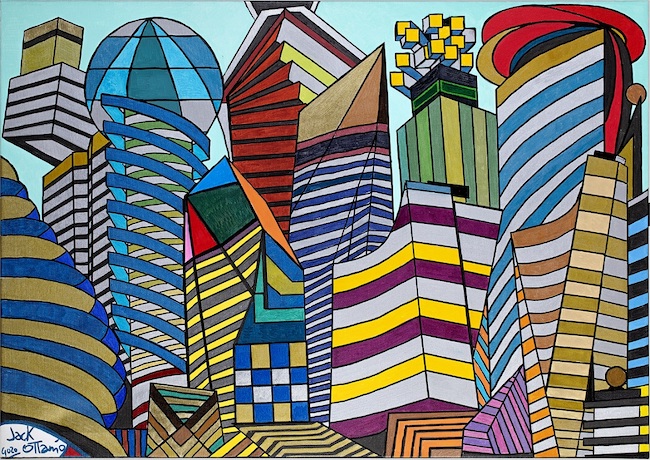La cultura artistica contemporanea si avvale e si arricchisce delle esperienze del passato recente, così come della facilità di un approccio conoscitivo più ampio, per dar vita a singolari linguaggi espressivi che spesso riescono a generare nuovi e inediti stili attraverso i quali i protagonisti dell’arte attuale esprimono se stessi ma anche i tempi nei quali vivono, con tutte le caratteristiche che portano con sé. Il protagonista di oggi svela, attraverso le sue tele vivaci e vitali, un approccio all’esistenza e a tutto ciò che il suo sguardo incontra, decisamente positivo, divertito e in grado di filtrare ogni cosa con il proprio caleidoscopio emozionale che viene trasmesso in maniera semplice e diretta all’osservatore.
Nei primi decenni del Novecento l’arte subì uno stravolgimento dovuto alla necessità di distaccarsi dalle regole classiche e accademiche che avevano contraddistinto le correnti stilistiche dei secoli precedenti, ma anche alla ricerca di modi per affermare la supremazia del gesto plastico e creativo sui nuovi metodi di riproduzione dell’immagine – la fotografia – e per divenire forte e incisiva testimonianza del cambiamento dei tempi e delle rapide modificazioni che la società stava compiendo. Alla luce di questo intento nacquero alcuni movimenti che decretarono l’inizio, e furono la base, di trasformazioni successive e altri che invece che segnarono una profonda traccia nel percorso artistico e che rappresentarono il distacco totale da tutti gli schemi precedenti. Il tema comune a molte delle correnti dell’inizio del Ventesimo secolo fu la scomposizione dell’immagine, quel distacco dalla realtà così come osservata che era messa sotto una lente diversa, quella della suddivisione in virtù della quale si doveva andare a infondere il senso di movimento e di velocità, come nel caso del Futurismo, oppure della semplificazione della profondità e della prospettiva per dare all’osservatore punti di vista molteplici svelati da un’inedita bidimensionalità, come nel caso del Cubismo. In entrambi i casi, sia che si osservasse una delle colorate e sfaccettate tele di Filippo Tommaso Marinetti sia che ci si ponesse di fronte a una delle opere distorte di Pablo Picasso, ciò che colpiva era la capacità di modificare e rappresentare la realtà attraverso una geometricizzazione in grado di comporre immagini inedite. L’estremizzazione di questo concetto diede vita a un distacco maggiore da ciò che l’occhio conosceva e osservava che trovò la sua espressione nell’Astrattismo Geometrico in cui forme e colori dovevano essere essenziali a definire e affermare l’assoluta superiorità del gesto plastico su qualsiasi attinenza alla figurazione. L’artista milanese Jack Ottanio attinge a tutti e tre i movimenti del Novecento per generare una propria personale cifra pittorica dove la geometria diviene il mezzo descrittivo per creare una realtà differente, una ricomposizione semplificata e schematica di ciò che lo sguardo osserva, un mondo parallelo in cui l’immaginazione filtra e arricchisce tutto di colori, di positività, di approccio sorridente alla vita.
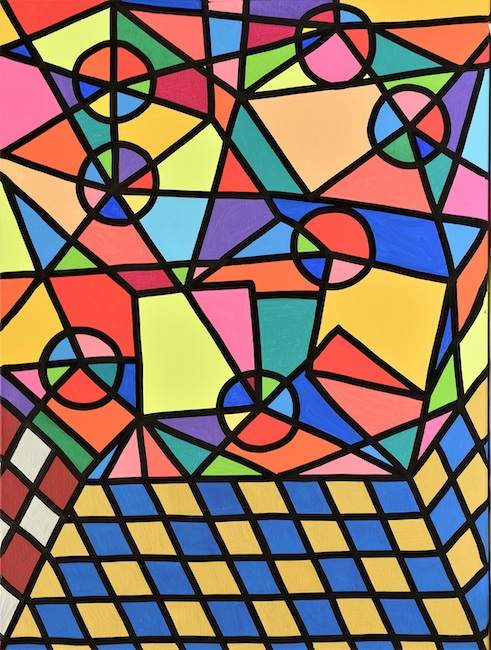
L’aver fatto molti viaggi lo ha portato a contatto con culture differenti, apprendendosi così alla molteplicità dei punti di vista e alla poliedricità di ogni singolo essere umano, scoprendo la bellezza dell’empatia, dell’inclusività che conduce verso una comunicazione aperta e serena; ed è proprio questa necessità di narrare la singolarità dell’osservato a divenire caratteristica principale di Jack Ottanio, le cui tele presentano una sintesi tra Astrattismo Geometrico con il quale racconta paesaggi italiani e scenari metropolitani dando ai palazzi un aspetto meno rigido, meno rigoroso in virtù della gamma cromatica intensa, vivace, gioiosa, tra Cubismo che emerge in particolar modo nei ritratti in cui, ancora una volta non rinuncia ai colori Pop, e il Futurismo attraverso la cui frammentazione riesce a infondere movimento alle onde del mare spesso coprotagoniste delle opere dedicate alle meravigliose isole del nostro Bel Paese.
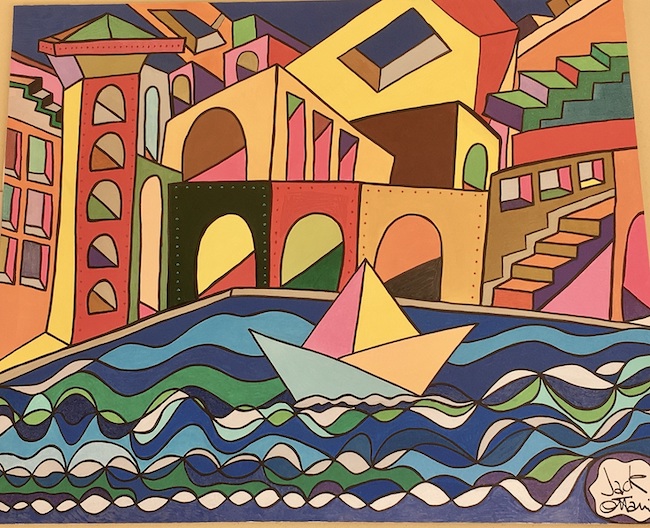
Nel dipinto San Marco 2050 Ottanio immagina la piazza veneziana completamente invasa dalle acque della laguna eppure non vi è alcun segno della disperazione e della devastazione generata da un evento avverso, tutt’altro, l’artista guarda alla trasformazione con ottimismo mostrando la capacità di adattamento dell’essere umano, così come la tendenza dei veneziani a sapersi rigenerare, a saper trovare un modo per sopravvivere agli accadimenti e disegnare un nuovo presente. La barca di carta, di quelle create dai bambini, è un simbolo giocoso che però rappresenta tutta la tendenza di Ottanio ad accettare ciò che non può essere cambiato, ed è forse questo il suggerimento che dà all’osservatore, quello di prendere atto della necessità, e della capacità insita nelle forme viventi, di adattarsi alle modificazioni che si verificano.
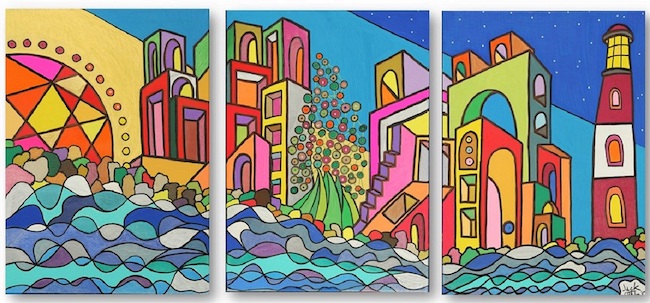
Il medesimo senso di movimento del mare dato da forme geometriche apparentemente fluttuanti è presente nell’opera Trittico di Farovecchio 2050 dove la vivacità delle case diventa predominante sul paesaggio marino, per sottolineare quanto i colori, quelli che fuoriescono da un approccio positivo alla vita, siano in grado di fare la differenza nell’esistenza di ciascuno, al punto di illuminare la notte. È un’interpretazione allegra ed entusiasta quella di Jack Ottanio, una capacità di dare un senso insolito alle cose, agli oggetti, ai paesaggi osservati, come se nel suo mondo fantastico vi fosse spazio solo per sensazioni felici, perché in fondo è quello l’unico modo per proseguire nel cammino della vita, cercando la piacevolezza in tutto ciò che viene vissuto, in tutto ciò che accade.
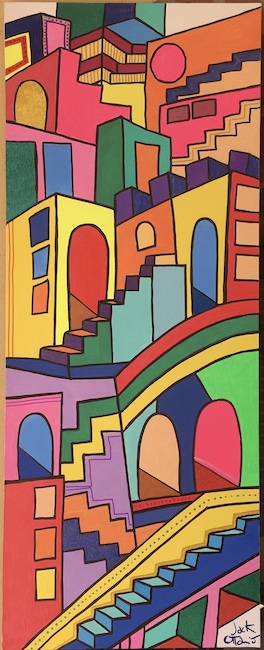
In Borgo Capri 2050 l’artista si avvicina ai disegni incoerenti e capovolti di Maurits Cornelis Escher per quella tendenza a sovvertire la prospettiva, a creare scale che vanno verso il nulla e finestre e porte senza un reale accesso, sempre mantenendo però l’approccio ludico che infonde all’osservatore la sensazione di trovarsi di fronte a un paesaggio ideale dove forse sarebbe affascinante vivere, scoprirne i misteri con lo stesso spirito di avventura del bambino che ancora vive dentro di sé. Si lascia conquistare dalla bellezza delle case arroccate sull’isola Jack Ottanio, che lo intrigano più del mare e del cielo proprio perché vanno a stimolare la sua innata curiosità nei confronti dell’essere umano e di tutto ciò che lo riguarda.
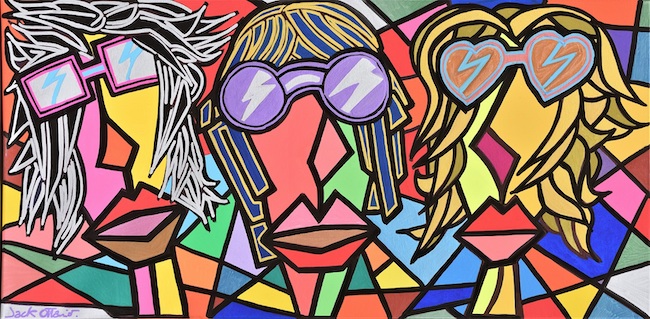
Nei ritratti invece l’artista mostra la sua anima più Pop e al tempo stesso cubista, per le sfaccettature spigolose attraverso cui descrive i dettagli dei personaggi, come nella tela The Brambilla sisters, che però sono accese da tonalità piene, forti, decise, a sottolineare la personalità sfaccettata delle protagoniste, fortemente rock e contemporanee per il look scelto, per il glamour che traspare dalla loro immagine; anche in questo caso la geometricità ricompone e dona carattere ai volti ma anche allo sfondo, tanto quanto la capacità caleidoscopica di Ottanio contribuisce a infondere il suo orientamento sorridente e allegro nei confronti della realtà che lo circonda.
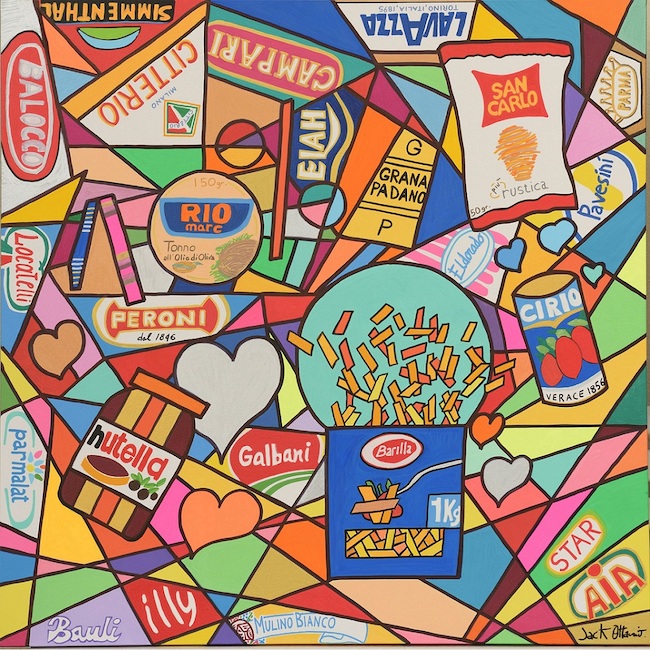
Il legame con la cultura Pop italiana viene completamente rappresentato nell’opera Italians Pop Icons in cui mette in evidenza tutti i marchi gastronomici cari alla nostra cultura, facendo così il verso alle opere dedicate alle zuppe statunitensi dal fondatore della Pop Art Andy Warhol.
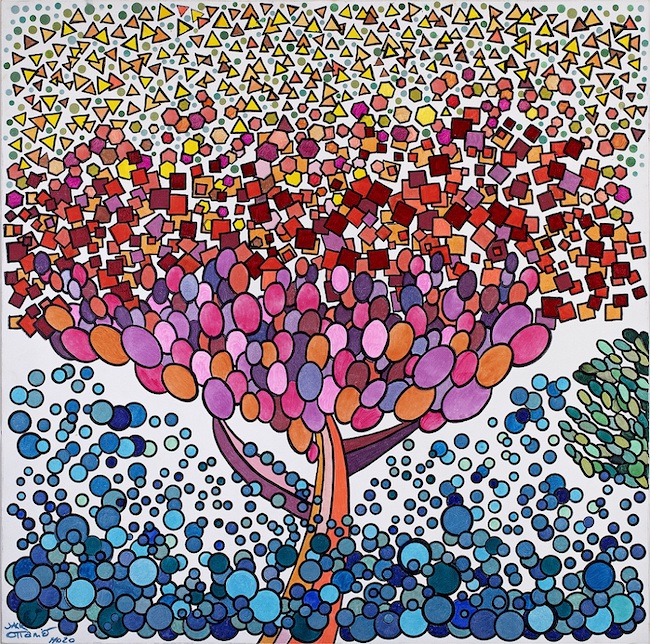
Tecnica mista costituita da acrilici, metalli, glitter, markering contraddistinguono le opere di Jack Ottanio che nel corso della sua carriera ha ricevuto numerosi riconoscimenti per l’originalità del suo lavoro, è rappresentato da molte gallerie in Italia, e ha al suo attivo la partecipazione a molte mostre personali e collettive anche all’estero – Montreaux, Parigi, Zurigo e Budapest – ; le sue tele sono esposte in luoghi istituzionali e inserite nei più importanti cataloghi italiani di arte contemporanea.
JACK OTTANIO-CONTATTI
Email: jack@jackottanio.com
Sito web: https://jackottanio.com/
Facebook: https://www.facebook.com/jackottaniometropolitanartist
Instagram: https://www.instagram.com/jack_ottanio/
Linkedin: https://www.linkedin.com/in/jack-ottanio-9b23251a8/
The colourful world of Jack Ottanio, between Pop visions and geometrically decomposed views
Contemporary artistic culture makes use of and is enriched by the experiences of the recent past, as well as the ease of a broader cognitive approach, to give life to singular expressive languages that often succeed in generating new and unprecedented styles through which the protagonists of current art express themselves but also the times in which they live, with all the characteristics they bring with them. Today’s protagonist reveals, through his lively and vital canvases, an approach to existence and to all that his gaze encounters, decidedly positive, amused and able to filter everything with his own emotional kaleidoscope that is transmitted in a simple and direct manner to the observer.
In the first decades of the twentieth century, art underwent an upheaval due to the need to break away from the classical and academic rules that had distinguished the stylistic currents of previous centuries, but also to the search for ways to assert the supremacy of the plastic and creative gesture over the new methods of image reproduction – photography – and to become a strong and incisive witness to the changing times and the rapid transformations that society was undergoing. In the light of this intention were born some movements that decreed the beginning, and were the basis, of subsequent modifies and others that marked a profound trace in the artistic path and represented a total detachment from all previous schemes. The common theme of many of the currents of the early twentieth century was the decomposition of the image, that detachment from reality as observed, which was placed under a different lens, that of the subdivision by virtue of which a sense of movement and speed was to be instilled, as in the case of Futurism, or the simplification of depth and perspective to give the observer multiple points of view revealed by an unprecedented two-dimensionality, as in the case of Cubism. In both cases, whether one was looking at Filippo Tommaso Marinetti’s colourful and multifaceted canvases or at Pablo Picasso’s distorted artworks, what struck was the ability to modify and represent reality through a geometricisation capable of composing unprecedented images. The extreme nature of this concept gave rise to a greater detachment from what the eye knew and observed, which found its expression in Geometric Abstractionism in which shapes and colours had to be essential to define and affirm the absolute superiority of the plastic gesture over any reference to figuration.
Milanese artist Jack Ottanio draws on all three twentieth-century movements to generate his own personal style of painting in which geometry becomes the descriptive means for creating a different reality, a simplified and schematic recomposition of what the eye observes, a parallel world in which the imagination filters and enriches everything with colours, positivity and a smiling approach to life. Having travelled extensively has brought him into contact with different cultures, thus learning about the multiplicity of points of view and the multifaceted nature of every single human being, discovering the beauty of empathy, of inclusiveness that leads to an open and serene communication; and it is precisely this need to narrate the singularity of the observed that has become the main characteristic of Jack Ottanio, whose canvases present a synthesis between Geometric Abstractionism, with which he narrates Italian landscapes and metropolitan scenarios, giving the buildings a less rigid, less rigorous appearance by virtue of the intense chromatic range, between Cubism, which emerges particularly in the portraits in which, once again, he does not renounce Pop colours, and Futurism, through whose fragmentation he manages to infuse movement into the waves of the sea that are often the co-protagonists of the artworks dedicated to the marvellous islands of Italy. In the painting San Marco 2050, Ottanio imagines the Venetian square completely invaded by the waters of the lagoon, yet there is no sign of the despair and devastation generated by an adverse event. On the contrary, the artist looks at the transformation with optimism, showing the human being’s capacity to adapt, as well as the Venetians’ tendency to know how to regenerate, to find a way to survive the events and design a new present. The paper boat, one of those created by children, is a playful symbol that nevertheless represents Ottanio’s tendency to accept what cannot be changed, and perhaps this is the suggestion he gives the observer, that of taking note of the need, and of the capacity inherent in living forms, to adapt to the modifications that occur. The same sense of movement of the sea given by apparently fluctuating geometric shapes is present in the canvas Trittico di Farovecchio, where the liveliness of the houses becomes predominant over the seascape, underlining how colours, those that emerge from a positive approach to life, are able to make a difference in everyone’s existence, to the point of illuminating the night. Jack Ottanio’s interpretation is cheerful and enthusiastic, an ability to give an unusual meaning to the things, objects and landscapes he observes, as if in his fantastic world there were only room for happy sensations, because in the end that is the only way to continue along life’s path, seeking pleasure in everything that is experienced, in everything that happens.
In Borgo Capri, the artist approaches the incoherent, upside-down drawings of Maurits Cornelis Escher for his tendency to subvert perspective, to create staircases that lead to nowhere and windows and doors with no real access, but always maintaining the playful approach that gives the observer the sensation of being in front of an ideal landscape where perhaps it would be fascinating to live, to discover its mysteries with the same spirit of adventure as the child who still lives inside himself. He is captivated by the beauty of the houses perched on the island of Jack Ottanio, which intrigue him more than the sea and the sky precisely because they stimulate his innate curiosity about the human being and everything about him. In the portraits, on the other hand, the artist shows his more Pop and at the same time cubist soul, for the angular facets through which he describes the details of the characters, as in the canvas The Brambilla sisters, which are however lit up by full, strong, decisive tones, to underline the multi-faceted personality of the protagonists, strongly rock and contemporary for the look chosen, for the glamour that transpires from their image; In this case too, geometricity recomposes and gives character to the faces but also to the background, just as Ottanio’s kaleidoscopic capacity contributes to instilling its smiling and cheerful orientation towards the reality that surrounds it. The link with Italian Pop culture is fully represented in the work Italians Pop Icons in which he highlights all the gastronomic trademarks dear to our culture, thus echoing the artworks dedicated to American soups by Pop Art founder Andy Warhol. Jack Ottanio’s paintings are characterised by a mixed technique consisting of acrylics, metals, glitter and markering. During his career he has received numerous awards for the originality of his work, is represented by many galleries in Italy, and has participated in several solo and group exhibitions abroad – Montreaux, Paris, Zurich and Budapest -; his canvases are exhibited in institutional sites and included in the most important Italian contemporary art catalogues.


